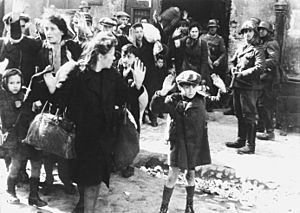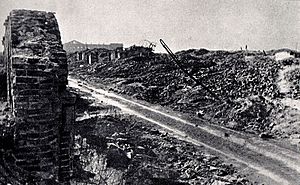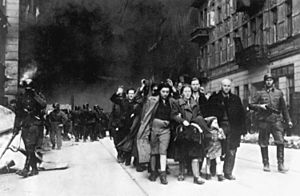Warsaw Ghetto Uprising facts for kids
Quick facts for kids Warsaw Ghetto Uprising |
|||||||
|---|---|---|---|---|---|---|---|
| Part of World War II and the Holocaust | |||||||
 Jewish women and children forcibly removed from a bunker; one of the most iconic pictures of World War II. |
|||||||
|
|||||||
| Belligerents | |||||||
Supported by:
|
|||||||
| Commanders and leaders | |||||||
| Strength | |||||||
| Daily average of 2,090, including 821 Waffen-SS | About 600 ŻOB and about 400 ŻZW fighters, plus a number of Polish fighters | ||||||
| Casualties and losses | |||||||
| German figures: 17 killed 93 wounded Jewish resistance estimate: 300 casualties |
56,065 killed/and or captured of which approximately 36,000 deported to extermination camps (German estimate) | ||||||
The Warsaw Ghetto Uprising was a brave act of Jewish resistance during World War II. It happened in 1943 in the Warsaw Ghetto in German-occupied Poland. Jewish people fought back against Nazi Germany's plan to send the remaining ghetto residents to Majdanek and Treblinka death camps.
In the summer of 1942, over 250,000 Jews were sent from the ghetto to Treblinka. After this, the Jews who remained started building secret bunkers. They also smuggled weapons and explosives into the ghetto. Two main groups formed: the Jewish Combat Organization (ŻOB) and the Jewish Military Union (ŻZW). They began to train for a fight.
In January 1943, a small resistance effort against another roundup was partly successful. This encouraged Polish resistance groups to seriously support the Jews. The uprising officially began on April 19, 1943. The ghetto residents refused to surrender to the German police commander, Jürgen Stroop. He then ordered the ghetto to be burned down, block by block. The uprising ended on May 16, 1943. About 13,000 Jews were killed. German casualties were likely fewer than 150.
This uprising was the largest single revolt by Jews during World War II. The fighters knew they couldn't win and that they probably wouldn't survive. Marek Edelman, one of the few surviving commanders, said they fought "not to allow the Germans alone to pick the time and place of our deaths." The United States Holocaust Memorial Museum calls the uprising "one of the most significant occurrences in the history of the Jewish people."
What Happened After the Uprising
After the uprising ended, most of the burned houses were torn down. The Warsaw concentration camp was built in their place. Thousands of people died in this camp or were executed in the ghetto ruins. At the same time, the SS continued to hunt for any Jews still hiding in the destroyed area.
The Warsaw Ghetto Uprising of 1943 happened over a year before the larger Warsaw Uprising of 1944. By the time of the city-wide uprising, the ghetto had been completely destroyed. The 1944 uprising was part of Operation Tempest, a plan for a nationwide rebellion in Poland.
Some survivors of the Warsaw Ghetto Uprising were known as "Ghetto Fighters." They later founded a kibbutz (a community settlement) called Lohamei HaGeta'ot in Israel. In 1984, members of this kibbutz published Daphei Edut, which means "Testimonies of Survival." These four books contain personal stories from 96 kibbutz members. The settlement also has a museum and archives to remember the Holocaust.
The last Jewish resistance fighter from the uprising, Simcha Rotem, passed away in Jerusalem on December 22, 2018. He was 94 years old.
Images for kids
-
The cover page of The Stroop Report with International Military Tribunal in Nuremberg markings.
See Also
 In Spanish: Levantamiento del gueto de Varsovia para niños
In Spanish: Levantamiento del gueto de Varsovia para niños
- Destruction of Warsaw
- Sobibor uprising
- Białystok Ghetto uprising
- Ghetto uprisings
- Battle of Muranów Square




















